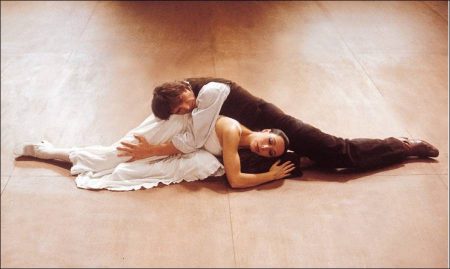Blood Wedding movie storyline. A bride elopes with her lover on the very day of her wedding. The groom follows the two lovers, and a knife fight takes place. The rivals stab each other and the only wedding that takes place is that one knotting their destinies together in death. A blood wedding. Group of dancers put Lorca’s ‘Blood Wedding’ on stage, the tragic play about a married man who is still in love with his ex girlfriend, and tries to get back to her despite her planned wedding.
Blood Wedding is by far the simplest and most stripped-down film in the trilogy, running just a bit over an hour and spending its first thirty minutes or so just gathering the dancers together to get into character and do their warm-up exercises. We hear a short voice-over of Gades telling us about his early days as a Madrid street kid who wound up as a dancer almost by happenstance, a passage maybe of more interest once we understand that Gades was an award-winning superstar in the international flamenco scene.
After Gades calls the company together to practice a few phrases together (seen in the above clip), Blood Wedding‘s kinetic energy begins to take off in earnest. But it’s a slow smoldering build-up, and any who’s expecting a Latin version of Riverdance will probably be a bit disappointed. Saura and Gades don’t resort to flashy steps just for the sake of drumming up easy applause. They’re creating a cinematic experience and doing so in a way that leads the viewer more directly into the creative process.
The entire film is a plainly staged and shot depiction of a studio-contained rehearsal session. The dancers are in costume, but there are no props, no stage lights, no illusions of theatricality to pull our attention away from the sheer physical spectacle that is at the heart of flamenco. Musical accompaniment is also rather minimal – at first, just guitar and a trio of male singers, later, a small band and solo vocalist take over.
The story they tell is based on timeless themes, adapted from a well-known play by 20th century Spanish avant-garde writer Federico Garcia Lorca. Blood Wedding is about a pair of tragic young lovers who are denied the opportunity to pursue their romance openly due to outside pressures: he has abandoned his wife and child, she has been pledged to another through a traditional arranged marriage.
Because of the rehearsal setting, some of the story elements don’t come through as clearly on first viewing as they probably would in a full production, but the main point of the film is not the melodramatic narrative, but to create a unique blend of music, body and camera movement that watching the performance in person could not approximate.
Unless we were given permission to walk around on stage in the midst of the dancers, I suppose – but even then, as you can see in this beautifully rendered clip of the lovers’ last dance before she becomes a reluctant bride, Saura finds ways to put his camera in places that the normal human gaze can’t usually reach.
Cristina Hoyos, the woman at the heart of this rivalry, dominates just about every scene she appears in. Wearing a white dress, in a brightly lit room in front of those tall white windows, her dark features and intense facial expression become all the more riveting as she convincingly conveys the peculiar agony that accompanies a passion desire that the world refuses to allow or understand.
It’s probably not much of a spoiler to hint that Blood Wedding doesn’t lead to a happy ending – the title itself implies tragically doomed romance clearly enough. But what would be an unconscionable spoiler on my part is to post a clip of the magnificent finale that takes up the last nine minutes or so of the film: a gripping and hypnotic slow-motion knife fight between the two men who each hold their claim over the bride that must be seen only after the proper context has been established. It’s quite an impressive display of the passion, tradition and exquisite skill that even a non-dancing yokel like me can recognize and respect.
Blood Wedding (Spanish: Bodas de Sangre) is a 1981 Spanish musical film written and directed by Carlos Saura. It was directed and choreographed in the flamenco style. It is the first part of Saura’s 1980s flamenco trilogy, and is followed by Carmen (1983) and El amor brujo (1986). The film depicts Antonio Gades and his dance company performing a flamenco adaptation of Federico García Lorca’s play Blood Wedding. As with all Saura’s flamenco films, the film is overtly theatrical: it begins with the company arriving at the studio and putting on costumes and makeup. The dance is then performed in a bare windowed space with a minimum of props and no set. There are no elaborate costumes and many of the actors wear only their rehearsal clothes. It was shown out of competition at the 1981 Cannes Film Festival.
Blood Wedding (1981)
Directed by: Carlos Saura
Starring: Antonio Gades, Cristina Hoyos, Juan Antonio Jiménez, Carmen Villena, Pilar Cárdenas, Lario Díaz, Enrique Esteve, Elvira Andrés, Azucena Flores, Cristina Gombau, Marisa Neila, Antonio Quintana, Quico Franco, Candy Román
Screenplay by: Carlos Saura, Antonio Artero, Antonio Gades, Alfredo Mañas
Cinematography by: Teodoro Escamilla
Film Editing by: Pablo González del Amo
Set Decoration by: Rafael Palmero
Makeup Department: Ramón de Diego
Music by: Emilio de Diego
MPAA Rating: None.
Distributed by:
Release Date: March 9, 1981 (Spain)
Views: 256



